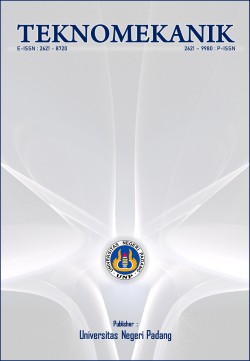Total Suspended Particulate (TSP) simulation using the gaussian dispersion model
DOI:
https://doi.org/10.24036/jptk.v6i2.33823Keywords:
TSP, Dispersion, Gauss, Surfer, Ambient air pollutionAbstract
Air pollution is one of the most dangerous and worrying. One of the causes of air pollution is dust or Total Suspended Particulate (TSP), namely particles with a diameter of <100 μm. The Total Suspended Particulate causes visual distrurbances and respiratory disorders such as URTI (Upper Respiratory Tract Infection). According to data from Badan Pusat Statistik Kota Padang in 2018, URTI represents the highest complaint in the district Lubuk Begalung as many as 5,534 cases (28%). In the district has industrial and transportation activities which are a source of air pollution. However, in there haven’t real time monitoring of air pollution, so it is necessary to carry out air pollution simulations. This study aims to determine the concentration of TSP ambient air pollution and to analyze the distribution air pollutant in the Lubuk Begalung District, Padang City. The research method used a quantitative, where the emission inventory and meteorological data used the Gauss dispersion model and surver 15 software. The maximum TSP from measurement and modeling results was 113.42 µg/m3 and 27.16 µg/m3. This result explain about the TSP concentration is still below the National BMUA in PP RI No. 41 of 1999, which is 230 µg/m3 (still in good condition). This is different from previous studies because this study only considers sources of industrial emissions without other sources of pollution. The result of the TSP distribution is moving increasingly towards the Southwest from the emission source and reaches a maximum concentration at the coordinate point (-0.98103 oS, 100.34567 oE), according to the dominant wind direction.
Downloads
References
Ardianarsya, B. S. 2019. Inventarisasi Emisi dan Permodelan Dispersi Emisi PM (Particullate Matter) 2,5 PT. Semen Indonesia (PERSERO) TBK. Tugas Akhir, Politeknik Perkapalan Negeri Surabaya,Surabaya
Badan Pusat Statistik Kota Padang. 2019. Kecamatan Lubuk Begalung Dalam Angka 2019. CV. Sarana Multi Abadi. Kota Padang
Colls, Jeremy. 2009. Air Pollution, Third Edition, Spon Press Tylor & Francis Group, London.
Ruslinda, Y., Hafidawati, Roza,. 2008. Konsentrasi dan Karakteristik Particulate Matter 2,5 µm (PM2,5) di Udara Ambien Kawasan Pasar Raya Padang. Jurnal Dampak. Vol. 5 No: 1.
IQAir. 2020. 2019 World Air Quality Report. IQAir North America, Inc. North Amerika
Peavy, Howard S, Rowe, Donald R, Tchobanoglous, George. 2013. Environmental Engineering. McGraw Hill India.
Permatasari, A. I. Ayu, Sasongko, D. P., Buchori, I. 2014. Analisis Dispersi Poluten Udara Menggunakan Model Dispersi Gauss dan Pemetaan Surfer 10. Jurnal EKOSAINS, Vol 6 No: 3, November 2014 p: 1–19.
Sepriani, K.D., Turyanti, A., Kudsy, M. 2014. Sebaran Partikulat (PM10) Pada Musim Kemarau di Kabupaten Tangerang dan Sekitarnya. Jurnal Sains dan Teknologi Modifikasi Cuaca. Vol. 15 No: 2, p: 89 – 100
Ulpah, M., 2015. Hubungan Kadar Debu Ambien dengan Gejala ISPA pada Balita di Wilayah Kerja Posyandu Kaca Piring Kelurahan Mugirejo Kecamatan Sungai Pinang. Naskah Publikasi, Sekolah Tinggi Ilmu Kesehatan Muhammadiyah, Samarinda
World Health Organization. 2018. Ambient (outdoor) air pollution. www.who.int/mediacentre/factsheets/fs313/en. (23/05/2020)
Visscher, A. 2014. Air Dispersion Modelling. John Willwy & Sons Inc. New Jersey
Downloads
Published
How to Cite
Issue
Section
License
Copyright (c) 2023 Yaumal Arbi, Nofriya Nofriya, Rahma Fitrianti

This work is licensed under a Creative Commons Attribution 4.0 International License.





